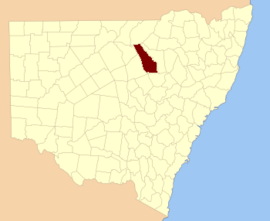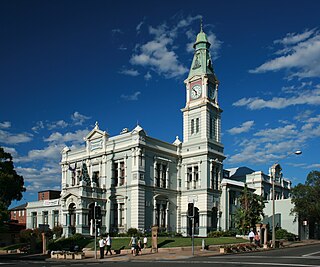
The Inner West Sydney is an area directly west of the Sydney central business district, New South Wales, Australia. The suburbs of the Inner West are predominantly located along the southern shore of Port Jackson, stretching south to the shores of the Cooks River. The western boundary is Homebush Bay Drive & Centenary Drive.

Leichhardt is a suburb in the Inner West of Sydney, in the state of New South Wales, Australia. Leichhardt is located 5 kilometres west of the Sydney central business district (CBD) and is the administrative centre for the local government area (LGA) of the Inner West Council. The suburb is bordered by Haberfield to the west, Annandale to the east, Lilyfield to the north and Petersham, Lewisham and Stanmore to the south.

Cumberland County is a county in the State of New South Wales, Australia. Most of the Sydney metropolitan area is located within the County of Cumberland.
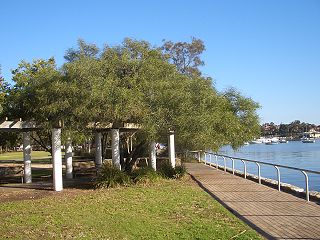
Lilyfield is a suburb in the Inner West of Sydney, in the state of New South Wales, Australia. Lilyfield is located 6 kilometres west of the Sydney central business district, in the local government area of the Inner West Council.
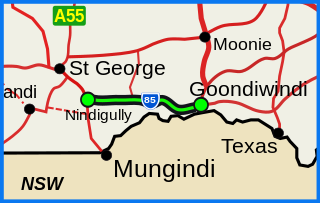
The Barwon Highway is one of the shorter state highways of Queensland, Australia. It starts at the Carnarvon Highway in Nindigully, 44 kilometres south of St George, and travels east for about 155 kilometres until it reaches Goondiwindi, where it terminates at the Leichhardt Highway.

Sydney Secondary College is a multi-campus urban government-funded, co-educational, dual modality, partially academically selective and comprehensive secondary day school, located in the Inner-West region of Sydney, New South Wales, Australia.

Corowa is a town in the state of New South Wales in Australia. It is on the bank of the Murray River, the border between New South Wales and Victoria, opposite the Victorian town of Wahgunyah. It is the largest town in the Federation Council and was the administrative centre of the former Corowa Shire. The name could have derived from an Aboriginal word referring to the curra pine which yielded gum used by Aborigines to fasten the heads of spears to the shafts. Another translation is rocky river.

The Municipality of Leichhardt was a local government area in the inner-west region of Sydney, New South Wales, Australia. It is about 10 kilometres (6.2 mi) west of the Sydney central business district. On 12 May 2016, Leichhardt merged with Marrickville Council and the Municipality of Ashfield to form the Inner West Council.

Leichhardt Oval is a football and soccer stadium in Leichhardt, New South Wales, Australia. It is currently one of 3 home grounds for the Wests Tigers National Rugby League team, along with Campbelltown Stadium and Western Sydney Stadium. Prior to its merger with the Western Suburbs Magpies, it was the longtime home of the Balmain Tigers, who used the ground from 1934–1994 and 1997–1999.

The Hawthorne Canal, a southern tributary of the Parramatta River, is a heritage–listed artificial waterway located in the western reaches of Sydney Harbour, in the inner–western Sydney suburbs of Lewisham, Summer Hill, Haberfield, and Leichhardt in New South Wales, Australia.

The Dawson River is a river located in Central Queensland, Australia.
The following lists events that happened during 1848 in Australia.
Leichhardt was an electoral district of the Legislative Assembly in the Australian state of New South Wales, created in 1894, with the abolition of multi-member electorates and partly replacing Balmain, and named after and including the Sydney suburb of Leichhardt. With the introduction of proportional representation, it was absorbed into the multi-member electorate of Western Suburbs. It was recreated in 1927, but was abolished in 1962.

Petersham Parish is one of the 57 parishes of Cumberland County, New South Wales, a cadastral unit for use on land titles. It is located to the south of Iron Cove, Rozelle Bay and the Parramatta River, and to the north of Cooks River. It includes the suburbs of Balmain, Leichhardt, Petersham, Newtown, Marrickville, Tempe, Glebe and St Peters.
Moreton, Wide Bay, Burnett and Maranoa, and from 1857 Moreton, Wide Bay, Burnett, Maranoa, Leichhardt and Port Curtis, was an electoral district of the Legislative Assembly in the Australian state of New South Wales created in 1856 and consisted of the pastoral districts around the early settlements of Moreton Bay; Wide Bay, near Maryborough; the Burnett River, near Bundaberg; and the Maranoa region of South-western Queensland. In September 1856 the pastoral districts around the Leichhardt River in the Gulf of Carpentaria region and Port Curtis (Gladstone) were added to the electorate. The district was abolished for the 1859 election and replaced by the separate districts of East Moreton, West Moreton, Burnett and Leichhardt, while Maranoa became part of Darling Downs. All of these districts became part of Queensland when it was established as a separate colony in late 1859.
Leichhardt was an electoral district of the Legislative Assembly in the Australian state of New South Wales
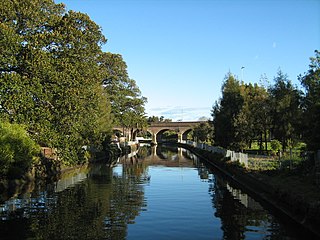
Johnstons Creek, formerly Johnston's Creek, is an urban gully, located in Sydney, Australia and situated in the Leichhardt local government area. The creek flows from Petersham, past Annandale, Camperdown, Forest Lodge and Harold Park, before spilling into Rozelle Bay, within Sydney Harbour.
William Henry Suttor (Senior) was an Australian pastoralist and politician.

The Leichhardt Campus of the Sydney Secondary College is a government-funded, co-educational, dual modality, partially academically selective and comprehensive junior secondary day school, located in the inner-western Sydney suburb of Leichhardt, New South Wales, Australia. Together with the senior school at the Blackwattle Bay Campus and the other junior school at Balmain Campus, the school is a part of the Sydney Secondary College.
